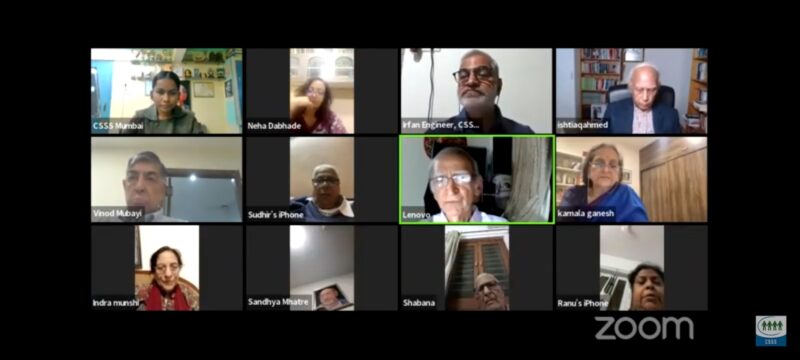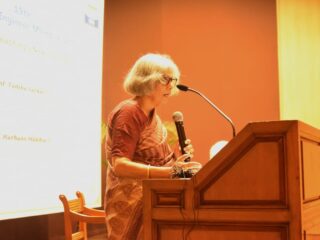Partition of India: An historical Account and its implications for India-Pakistan Relations
A report by Neha Dabhade
“The idea of Indian partition came from both the sides- Hindus and Muslim ideologues and there are ample examples to show it”, said Prof. Ishtiaq Ahmed, prominent political scientist and author of number of books on India-Pakistan partition and relations, while delivering the 20th Dr. Asghar Ali Engineer Memorial Lecture on 3rd December, 2022 virtually. The title of the lecture was ‘Partition and India-Pakistan Relations’. Over 80 participants attended the lecture and engaged with Prof. Ahmed through questions and discussions after the lecture. The audience included scholars, professors and journalists. The Lecture was chaired by Prof. Vinod Mubayi, former nuclear scientist and editor of INSAF Bulletin.
Prof. Ishtiaq Ahmed in the lecture explained how the idea of separation of Muslim majority state from India took shape and the processes leading to the partition of India. He also explained the aftermath of partition and how the partition affected the subsequent India-Pakistan relations in the years to come. Against the popular belief that Jinnah was responsible for the partition, Prof. Ishtiaq traced the historical root of the idea of a separate Muslim state. However, he strongly argued that partition doesn’t find its roots in the lived experiences of the people on both the sides of the boundaries. Prof. Ahmed explained that while the logic of the partition was based on the idea that ‘if you do not belong to my faith, you are my enemy’, the lived experiences of the people of the Indian sub-continent point to the opposite. He pointed out that with the waves of migration; there was a mosaic of beliefs, customs and traditions in the Indian sub continent. Pluralism still thrived in India under the Muslim rule.
Then how did the idea of partition come about? Prof. Ishtiaq Ahmed pointed out that in the second half of the 20th Century; Sir Sayyad Ahmad Khan propagated the two nation theory. At about the same time, in 1858, Tarinicharan Chattopadhyay wrote the anti-Muslim manifesto called, ‘Bharat Varshiya Itihas’ where he blamed the Muslims for all the misfortunes and decline of Bengal. Prof. Ahmed continued to explain that in 1888, Moharram Ali Chisti of Lahore spoke about Partition and in 1917; the Kheri brothers of Delhi attended a conference in Stockholm where they presented their idea of establishing a socialist Islamic state. In 1918, the Aga Khan discussed the idea of establishment of an Anglo Mohammedian empire which created great fear in the minds of the Hindus in Punjab. Different sections of the Hindu right responded to this fear- the Arya Samaj in Punjab and Bhai Parmananda proposed the partition of India. Munje proposed the idea of reconverting all Muslims into Hinduism. Savarkar in 1923 propounded the idea of Hindutva. Lala Lajpat Rai who was initially a great supporter of Hindu-Muslim unity after the riot in Punjab in 1924 where the Hindus were brutally killed, supported the idea of partition. In 1938, Golwalkar went as far as saying that Indians should learn from Nazi Germany in how it purged the Jews. Golwalkar also made it clear that Muslims will not enjoy equality in India. Prof. Ahmed thus established that the ideas of partition was propounded and supported by both Hindu and Muslim ideologues.
Prof. Ahmed explained that however, the idea of partition as it took place was propounded by two thinkers. One was Sir Mohammad Iqbal who proposed a clear demarcation of land- he proposed a Muslim majority state in the North West of India. Similarly, the other example is of Choudhary Rehmat Ali who in 1933 in his works, ‘Now or Never’ at Cambridge proposed a separate Muslim state called Pakistan where ‘P’ stood for Punjab, ‘A’ for Afghania, ‘K’ for Kashmir and ‘istan’ for Sindh and Baluchistan. He was of the opinion that Hindus and Muslims were two different nations with completely irreconcilable world views which can’t co-exist peacefully together in one land. However, Prof. Ahmed pointed that that the Indian National Congress which was founded in 1885 stood between the partition and such divisive ideas. It strove for Hindu Muslim unity and became a vehicle to ventilate the concerns of Indians. It became a mass party under Mahatma Gandhi. He also led the Muslims in India in the Khilafat movement.
Processes leading towards Partition:
According to Prof. Ahmed, some factors were crucial leading to partition of India. One of them was the elections in 1937 after the 1935 Government of India Act. In the elections in 1937, the Indian National Congress (INC) won in the Hindu majority constituencies as well as the North West constituencies having concentration of Muslims. Muslim League was routed even in the Muslim majority constituencies. Motilal Nehru Report in Karachi envisaged India as a secular state and also announced the fundamental rights. Mohammad Ali Jinnah against the backdrop of the abysmal performance of the Muslim League resorted to communalism to get votes. Prof. Ahmed explained that Jinnah wanted to generate fear amongst the Muslims that Indian National Congress will not represent the interests of the Muslims in India and that Islam will be annihilated in India. Jinnah also accused the INC of allowing excesses against the Muslims in the constituencies it had won thus targeting Muslims. The Viceroy Linlithgow also said that there was no proof of INC targeting the Muslims. However the propaganda was believed by the Muslims.
Another factor which contributed to the partition was the position of Jinnah and Muslim League during the World War II. The INC demanded transfer of power to the people of India before Indians joined the British to support the war against Germany. Jinnah capitalized on the situation and extended full support to the British in its war efforts. In return, Jinnah demanded the right to self determination. In the Lahore Resolution subsequently, Jinnah demanded for a separate Pakistan. The INC started the Quit India movement and it was heavily crushed by the British by arresting the Congress leaders. Prof. Ahmed explained that while the INC was thus removed from the political landscape of India, this vacuum was filled by Jinnah and he helped the British recruit Muslims for the war. Though the INC leaders were released in 1945, Jinnah had imprinted on a section of the Muslims the need for Pakistan which manifested in the 1945-46 elections where the Muslim League won some constituencies owing to the support of some of the Muslim elite and Muslim zamindars.
Role of British in the Partition:
Meanwhile, the British Empire was trying to protect its own supremacy in the subcontinent amidst the inevitable transfer of power. The British was also fearful of the influence of the Communists in India and wanted to a counter weight to that possibility. British demanded access to Karachi Port facilities, Pakistan air field and Pakistan Army if Pakistan was formed. In May 1947, partition of India was announced by the British. The two province assemblies of Punjab and Bengal were to vote on the partition. These two provinces too were divided in two blocks- Hindu majority and Muslim majority. For partition to take effect, either of the blocks in each province had to vote for partition. On 21st June 1947 Bengal voted for partition and on 30th June, 1947 Punjab voted for partition. Subsequently, violence broke out in different parts of India. More than ten thousand people were killed in Bengal after the call for ‘Direct Action’. In Noakhali, Mahatma Gandhi went to calm the situation and appealed for peace. In Bombay there were attacks on Muslims. In Bihar, there were one sided attacks on the Muslims and three to five thousand people were killed. Nehru personally went to Bihar and restored law and order. This was a major difference between Jinnah and the INC leaders. Leaders like Gandhi, Nehru and Patel went to riot affected areas and appealed for calm whereas Jinnah never went to douse the flames of communal violence. INC leaders didn’t want to drive Muslims out of India. However, the largest exodus in history couldn’t be avoided.
India- Pakistan relations:
Prof. Ahmed stated that partition and the migration cast a long shadow on the India-Pakistan relations. The national identity in each of the country was constructed on different terms. But the attacks on the minorities in both the countries continued outside Punjab and Bengal. In India, leaders like Gandhi, Nehru and Patel brought the attacks of the Hindu right on Muslims under control and didn’t want to drive Muslims out. Thus, out of the 12% of Muslims in India who originally stayed back, only 2% migrated to Pakistan. Large number of Muslims stayed back in India owing to the promise of secularism which also reflected in the Constitution of India. On the other hand, the Hindus in Pakistan were driven out- only 1.6% of Hindus stayed back in Pakistan. However, Prof. Ahmed lamented that the ‘partition syndrome’ still lingered. Event like demolition of Babri Masjid brought spells of violence in Pakistan against the Hindus and vice-versa.
The lecture was well appreciated by the audience which despite the virtual medium of the lecture stayed on zoom for nearly three hours and asked many questions. This rich analytical account of the partition with fine details enriched the understanding of partition and how it unfolded. The Dr. Ashgar Ali Engineer Memorial lectures have been delivered by prominent scholars in the past including Prof. Romila Thapar, Prof. Irfan Habib, Prof. Christophe Jaffrelot, A. G Noorani, Prof. Rajeev Bhargava, Prof. Zoya Hasan, Prof. Harbans Mukhia, Prof. Tanika Sarkar and Dr. Syeda Hameed.











